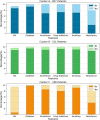Model for predicting drug resistance based on the clinical profile of tuberculosis patients using machine learning techniques
- PMID: 39650511
- PMCID: PMC11623081
- DOI: 10.7717/peerj-cs.2246
Model for predicting drug resistance based on the clinical profile of tuberculosis patients using machine learning techniques
Abstract
Tuberculosis (TB) is a disease caused by the bacterium Mycobacterium tuberculosis and despite effective treatments, still affects millions of people worldwide. The advent of new treatments has not eliminated the significant challenge of TB drug resistance. Repeated and inadequate exposure to drugs has led to the development of strains of the bacteria that are resistant to conventional treatments, making the eradication of the disease even more complex. In this context, it is essential to seek more effective approaches to fighting TB. This article proposes a model for predicting drug resistance based on the clinical profile of TB patients, using machine learning techniques. The model aims to optimize the work of health professionals directly involved with tuberculosis patients, driving the creation of new containment strategies and preventive measures, as it specifies the clinical data that has the greatest impact and identifies the individuals with the greatest predisposition to develop resistance to anti-tuberculosis drugs. The results obtained show, in one of the scenarios, a probability of development of 70% and an accuracy of 84.65% for predicting drug resistance.
Keywords: Anti-tuberculosis; Drug resistance; Machine learning; Tuberculosis.
© 2024 Falcão et al.
Conflict of interest statement
The authors declare that they have no competing interests.
Figures



Similar articles
-
Machine learning-based prediction of antibiotic resistance in Mycobacterium tuberculosis clinical isolates from Uganda.BMC Infect Dis. 2024 Dec 5;24(1):1391. doi: 10.1186/s12879-024-10282-7. BMC Infect Dis. 2024. PMID: 39639222 Free PMC article.
-
Beyond multidrug resistance: Leveraging rare variants with machine and statistical learning models in Mycobacterium tuberculosis resistance prediction.EBioMedicine. 2019 May;43:356-369. doi: 10.1016/j.ebiom.2019.04.016. Epub 2019 Apr 29. EBioMedicine. 2019. PMID: 31047860 Free PMC article.
-
Editorial: Current status and perspective on drug targets in tubercle bacilli and drug design of antituberculous agents based on structure-activity relationship.Curr Pharm Des. 2014;20(27):4305-6. doi: 10.2174/1381612819666131118203915. Curr Pharm Des. 2014. PMID: 24245755
-
[Development of antituberculous drugs: current status and future prospects].Kekkaku. 2006 Dec;81(12):753-74. Kekkaku. 2006. PMID: 17240921 Review. Japanese.
-
Tuberculosis drug resistance profiling based on machine learning: A literature review.Braz J Infect Dis. 2022 Jan-Feb;26(1):102332. doi: 10.1016/j.bjid.2022.102332. Epub 2022 Feb 15. Braz J Infect Dis. 2022. PMID: 35176257 Free PMC article. Review.
References
-
- Amiri MRJ, Siami R, Khaledi A. Tuberculosis status and coinfection of pulmonary fungal infections in patients referred to reference laboratory of health centers ghaemshahr city during 2007–2017. Ethiopian Journal of Health Sciences. 2018;28(6):683–690. doi: 10.4314/ejhs.v28i6.2. - DOI - PMC - PubMed
-
- Ashna H, Kaffash A, Khaledi A, Ghazvini Mutations of rpob gene associated with rifampin resistance among mycobacterium tuberculosis isolated in tuberculosis regional reference laboratory in northeast of Iran during 2015–2016. Ethiopian Journal of Health Sciences. 2018;28(3):299–304. doi: 10.4314/ejhs.v28i3.7. - DOI - PMC - PubMed
-
- Biagioni BT, Cavicchioli M, Massabni AC. Silver complexes for tuberculosis treatment: a short review. Química Nova. 2022;45:83–88. doi: 10.21577/0100-4042.20170812. - DOI
-
- BRASIL A. Bactérias de tuberculose resistentes a antibióticos desafiam. 2018. https://agenciabrasil.ebc.com.br/geral/noticia/2018-01/ https://agenciabrasil.ebc.com.br/geral/noticia/2018-01/ (accessed 31 January 2024)
-
- Cao F, Liang J, Li D, Bai L, Dang C. A dissimilarity measure for the k-modes clustering algorithm. Knowledge-Based Systems. 2012;26(5):120–127. doi: 10.1016/j.knosys.2011.07.011. - DOI
Associated data
LinkOut - more resources
Full Text Sources
